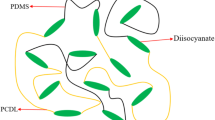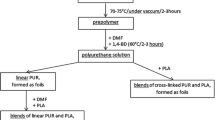Abstract
Two series of polyurethanes (PUR) were synthesized in a one-step procedure, using a polydimethylsiloxane (Mn ~ 2000 g/mol) in different molar ratios (10, 15, and 20 mol%) as soft segments, hexamethylene diisocyanate, and isophorone diisocyanate as a part of hard segments. Butane-1,4-diol was used as a chain extender in polyurethane synthesis. Obtained PURs were thoroughly studied and used for the preparation of blends with commercial thermoplastic polyurethane elastomer. In combination with commercial PUR, some synthesized samples behave as plasticizers, increasing the breaking strain and decreasing the Young’s modulus values. Blends with commercial PUR and 10 wt% of sample synthesized using an isophorone diisocyanate have shown an increase in strain values, but also values of break and Young’s modulus, resulting in materials with fully improved mechanical properties, and mostly higher hydrophobicity. The greatest values of breaking strain (1712.72%) and max strain (1637.09%) were recorded for the blend which contains 10 wt% of PUR sample based on isophorone diisocyanate and 20 mol% of polydimethylsiloxane, while blend which contains 10 wt% of PUR sample synthesized using isophorone diisocyanate and 10 mol% of polydimethylsiloxane has the greatest value of Young’s modulus (3.55 N/mm2). Prepared blends possess a lower surface tension values in comparison with the commercial PUR. The lowest value of surface tension (13.23 mN/m) was recorded for blend which contains 30 wt% of PUR sample synthesized using the isophorone diisocyanate and 20 mol% of polydimethylsiloxane.









Similar content being viewed by others
References
Rafee Z, Keshavarz V (2015) Synthesis and characterization of polyurethane/microcrystalline cellulose bionanocomposites. Prog Org Coat 86:190–193. https://doi.org/10.1016/j.porgcoat.2015.05.013
Prisacariu C (2011) Polyurethane elastomers: from morphology to mechanical aspects. Springer Science & Business Media
Jewrajka SK, Yilgor E, Yilgor I, Kennedy JP (2009) Polyisobutylene-based segmented polyureas. I. Synthesis of hydrolytically and oxidatively stable polyureas. J Polym Sci Polym Chem 47(1):38–48. https://doi.org/10.1002/pola.23118
Klinedinst DB, Yilgor E, Yilgor I, Beyer FL, Wilkes GL (2005) Structure-property behavior of segmented polyurethaneurea copolymers based on an ethylene-butylene soft segment. Polymer 46(23):10191–10201. https://doi.org/10.1016/j.polymer.2005.07.065
Mathur AB, Collier TO, Kao WJ, Wiggins M, Schubert MA, Hiltner A, Anderson JM (1997) In vivo biocompatibility and biostability of modified polyurethanes. J Biomed Mater Res 36:246–257. https://doi.org/10.1002/(sici)1097-4636(199708)36:2%3c246::aid-jbm14%3e3.0.co;2-e
Rogulska M (2019) Polycarbonate-based thermoplastic polyurethane elastomers modified by DMPA. Polym Bull 76:4719–4733. https://doi.org/10.1007/s00289-018-2632-3
Guney A, Kizilta A, Hasirci N, Endoğan Tanir T (2019) Synthesis and characterization of polycaprolactone-based segmentedpolyurethanes. Turk J Chem 43(2):452–463. https://doi.org/10.3906/kim-1801-44
Siegmann A, Cohen D (1997) Polyurethane elastomers containing polybutadiene and aliphatic diols: structure–property relationships. Polym Eng Sci 27:1187–1194. https://doi.org/10.1002/pen.760271512
Gaines GL (1981) On the surface morphology of block copolymers. Macromolecules 14:208–210
Silvestri A, Serafini PM, Sartori S, Ferrando P, Boccafoschi F, Milione S, Conzatti L, Ciardelli G (2011) Polyurethane-based biomaterials for shape-adjustable cardiovascular devices. J Appl Polym Sci 122:3661–3671. https://doi.org/10.1002/app.34779
Sommer SA, Byrom JR, Fischer HD, Bodkhe RB, Stafslien SJ, Daniels J, Yehle C, Webster DC (2011) Effects of pigmentation on siloxane–polyurethane coatings and their performance as foulingrelease marine coatings. J Coat Technol Res 8(6):661–670. https://doi.org/10.1007/s11998-011-9340-3
Briganti E, Losi P, Raffi A, Scoccianti M, Munaò A, Soldani G (2006) Silicone based polyurethane materials: a promising biocompatible elastomeric formulation for cardiovascular applications. J Mater Sci Mater Med 17:259–266. https://doi.org/10.1007/s10856-006-7312-4
Liao SK, Jang SC, Lin MF (2005) Phase behavior and mechanical properties of siloxane-urethane copolymer. J Polym Res 12(2):103–112. https://doi.org/10.1007/s10965-004-2501-7
Stefanović IS, Špírková M, Poręba R, Steinhart M, Ostojić S, Tešević V, Pergal MV (2016) Study of the properties of urethane-siloxane copolymers based on poly(propylene oxide)-b-poly(dimethylsiloxane)-b-poly(propylene oxide) soft segments. Ind Eng Chem Res 55(14):3960–3973. https://doi.org/10.1021/acs.iecr.5b04975
Zainuddin AA, Othaman R, Noor WS, Anuar FH (2016) 1H-NMR characterization of poly(ethylene glycol) and polydimethylsiloxane copolymer, In: AIP Conference Proceedings 1784:030023. https://doi.org/10.1063/1.4966761
Osman AF, Edwards GA, Schiller TL, Andriani Y, Jack KS, Morrow IC, Halley PJ, Martin DJ (2012) Structure–property relationships in biomedical thermoplastic polyurethane nanocomposites. Macromolecules 45:198–210. https://doi.org/10.1021/ma202189e
Chuang FS, Tsen WC, Shu YC (2004) The effect of different siloxane chain-extenders on the thermal degradation and stability of segmented polyurethanes. Polym Degrad Stab 84:69–77. https://doi.org/10.1016/j.polymdegradstab.2003.10.002
Zhu R, Wang X, Yang J, Wang Y, Zhang Z, Hou Y, Lin F (2017) Influence of hydroxyl-terminated polydimethylsiloxane on high-strength biocompatible polycarbonate urethane films. Biomed Mater 12:015011. https://doi.org/10.1088/1748-605X/12/1/015011
Pergal MV, Antic VV, Govedarica MN, Goaevac D, Ostojic S, Djonlagic J (2011) Synthesis and characterization of novel urethane-siloxane copolymers with a high content of PCL-PDMS-PCL segments. J Appl Polym Sci 122:2715–2730. https://doi.org/10.1002/app.33926
Zia KM, Ahmad A, Anjum S, Zuber M, Anjum MN (2011) Synthesis and characterization of siloxane-based polyurethane elastomers using hexamethylene diisocyanate. J Elastomers Plast 47(7):625–635. https://doi.org/10.1177/0095244314526746
Jee C, Kang KS, Bae J, Min JG, Kim BJ, Seo CM, Huh P (2020) Effect of molecular weight on the properties of polyethylene glycol polyurethane-co-polydimethylsiloxane polyurethane. Polym Plast Tech Mat 59:1967–1972. https://doi.org/10.1080/25740881.2020.1784211
Chuang F, Tsi H, Chow J, Tsen W, Shu Y, Jang S (2008) Thermal degradation of poly(siloxane-urethane) copolymers. Polym Degrad Stab 93:1753–1761. https://doi.org/10.1016/j.polymdegradstab.2008.07.029
Xue-Hai Y, Nagarajan MR, Grasel TG, Gibson PE, Cooper SL (1985) Polydimethylsiloxane–polyurethane elastomers: synthesis and properties of segmented copolymers and related zwitterionomers. J Polym Sci Polym Phys Ed 23(11):2319–2338. https://doi.org/10.1002/pol.1985.180231106
Riehle N, Thude S, Kandelbauer A, Tovar GE, Lorenz G (2019) Synthesis of soft polysiloxane-urea elastomers for intraocular lens application. J Vis Exp. https://doi.org/10.3791/58590
TyagiI D, Yílgör I, McGrath JE, Wilkes GL (1984) Segmented organosiloxane copolymers: 2 thermal and mechanical properties of siloxane—urea copolymers. Polymer 25(12):1807–1816. https://doi.org/10.1016/0032-3861(84)90255-6
Penhasi A, Gertler A, Baluashvili I, Elzinaty O, Shalev DE (2020) High modulus thermoplastic segmented polyurethane/poly(L-lactide) blends as potential candidates for structural implantable drug delivery systems. I. Structure-properties relationship study. J Appl Polym Sci 137:13749517. https://doi.org/10.1002/app.49517
Xiao F, Shen D, Zhang X, Hu S, Xu M (1987) Studies on the morphology of blends of poly(vinyl chloride) and segmented polyurethanes. Polymer 28:2335–2345. https://doi.org/10.1016/0032-3861(87)90396-X
Govorčin Bajsića E, Zdraveva E (2018) Photooxidative Stability of Polyurethane/Polycarbonate Blends. Chem Biochem Eng Q 32(2):191–203. https://doi.org/10.15255/CABEQ.2017.1196
Oh YS, Kim SR, Lee S, Lee JO, Kim BK (1995) Solution blends of polyacrylonitrile with segmented polyurethanes: effect of soft segments. J Macromol Sci Phys J Macromol Sci B B34(3):199–214. https://doi.org/10.1080/00222349508215529
Fromstein JD, Woodhouse KA (2002) Elastomeric biodegradable polyurethane blends for soft tissue applications. J Biomater Sci Polym Ed 13(4):391–406. https://doi.org/10.1163/156856202320253929
Rabiej SA (1991) Comparison of two X-ray diffraction procedures for crystallinity determination. Eur Polym J 27(9):947–954. https://doi.org/10.1016/0014-3057(91)90038-P
Owens DK, Wendt RC (1969) Estimation of the surface free energy of polymers. J Appl Polym Sci 13:1741–1747. https://doi.org/10.1002/app.1969.070130815
Çavuşa FK, Bekenb M, Özcanlıc Y, Sem A (2016) Study of PP/PET Blends. J Eng Technol Appl Sci 1(3):127–131
Król P, Uram L, Krol B, Pielichowska K, Walczak S-P, M, (2020) Synthesis and property of polyurethane elastomer for biomedical applications based on nonaromatic isocyanates, polyesters, and ethylene glycol. Colloid Polym Sci 298:1077–1093. https://doi.org/10.1007/s00396-020-04667-8
Vlad S, Spiridon I, Grigoras CV, Drobota M, Nistor A (2009) Thermal, mechanical and wettability properties of some branched polyetherurethane elastomers. E-Polymers. https://doi.org/10.1515/epoly.2009.9.1.37
Panwiriyarat W, Tanrattanakul V, Pilard JF, Pasetto P, Khaokong C (2013) Effect of the diisocyanate structure and the molecular weight of diols on bio-based polyurethanes. J Appl Polym Sci 130:453–462. https://doi.org/10.1002/app.39170
Halasa AF, Wathen GD, Hsu W, Matrana A, Mssie JM (1991) Relationship between interchain spacing of amorphous polymers and blend miscibility as determined by wide-angle X-ray scattering. J Appl Polym Sci 43:183–190. https://doi.org/10.1002/app.1991.070430115
Chou SF, Overfelt RA (2011) Tensile deformation and failure of North American porcupine quills. Mater Sci Eng C 31:1729–1736. https://doi.org/10.1016/j.msec.2011.08.002
Acknowledgements
Authors wish to express their gratitude to the Ministry of Education, Science and Technological Development, Republic of Serbia, project number 451-03-68/2020-14/ 200134 for financial support.
Funding
Funding provided by Ministarstvo Prosvete, Nauke i Tehnološkog Razvoja Republike Srbije.
Author information
Authors and Affiliations
Contributions
The manuscript was written through contributions of all authors. All authors have given approval to the final version of the manuscript.
Corresponding authors
Ethics declarations
Conflict of interest
The authors declare no competing financial interest.
Additional information
Publisher's Note
Springer Nature remains neutral with regard to jurisdictional claims in published maps and institutional affiliations.
Supplementary Information
Below is the link to the electronic supplementary material.
Rights and permissions
About this article
Cite this article
Erceg, T., Tanasić, J., Banjanin, B. et al. Surface, structural, and thermal properties of polydimethylsiloxane-based polyurethanes and their blends with thermoplastic polyurethane elastomer. Polym. Bull. 79, 10909–10929 (2022). https://doi.org/10.1007/s00289-021-04010-3
Received:
Revised:
Accepted:
Published:
Issue Date:
DOI: https://doi.org/10.1007/s00289-021-04010-3




